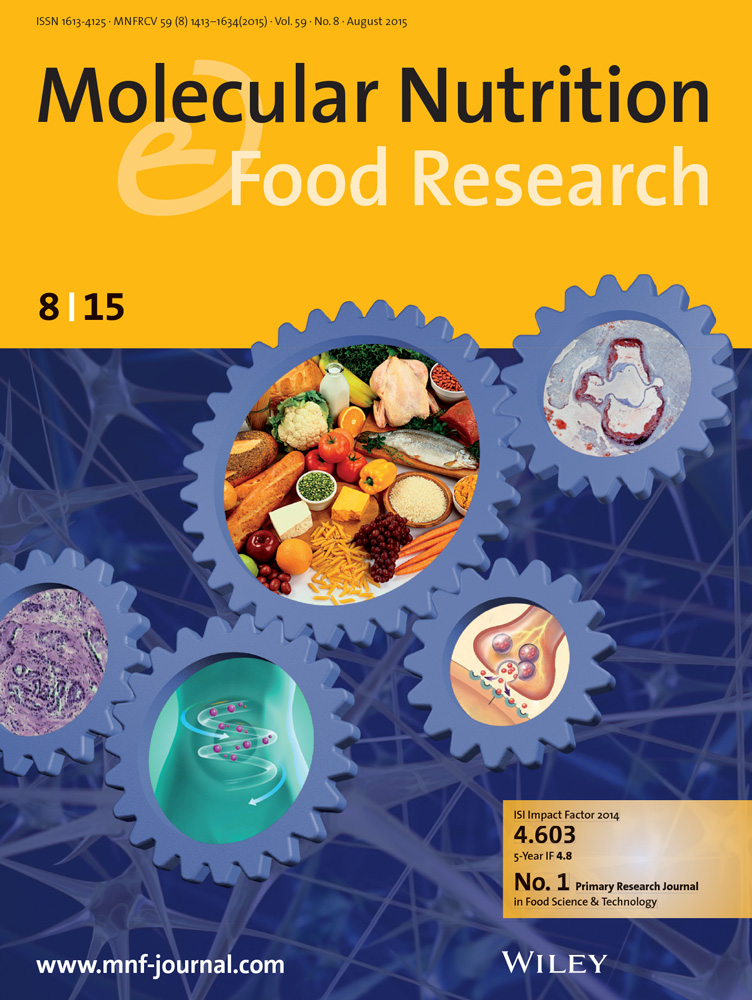马蹄莲多酚。参数。改善ffa诱导的L02细胞肝脂肪变性,减少秀丽隐杆线虫的脂质积累
IF 4.5
2区 农林科学
Q1 FOOD SCIENCE & TECHNOLOGY
引用次数: 0
摘要
Mallotus peltatus(海葵)参数。(MPMA)是中国海南省的一种专门用来泡茶的植物。然而,对其降血脂活性的研究很少。本研究从60%乙醇提取的MPMA中纯化了三个多酚组分(MPMAP-1、MPMAP-2和MPMAP-3),并通过建立ffa诱导的L02细胞模型来评估其降血脂活性,以确定脂质积累、抗氧化酶活性以及Nrf2/ARE途径和脂质代谢相关的基因水平。此外,采用秀丽隐杆线虫(C. elegans)建立非诱导和高糖诱导模型,评价MPMAP-1的降脂活性。结果表明,三种多酚均能显著抑制fa诱导的L02细胞脂质积累,降低细胞内MDA含量,提高CAT、SOD和GPx活性。qRT-PCR结果表明,通过调控Nrf2/ARE信号通路和脂质代谢通路mRNA的相对表达量,可以调控L02细胞的脂肪积累量。非诱导模型和高糖诱导模型表明,MPMAP-1能够降低秀丽隐杆线虫的脂质积累和ROS水平,提高抗氧化酶的活性。综上所述,我们的研究结果表明,MPMA的多酚化合物可能是一种有前景的降脂天然产物。本文章由计算机程序翻译,如有差异,请以英文原文为准。

Polyphenols From Mallotus peltatus (Geiseler) Mull. Arg. Ameliorates FFA-Induced Hepatic Steatosis in L02 Cells and Reduces Lipid Accumulation in Caenorhabditis elegans
Mallotus peltatus (Geiseler) Mull. Arg. (MPMA) is a specialty plant used to make tea in Hainan Province, China. However, its hypolipidemic activity has been rarely studied. In this study, three polyphenol fractions (MPMAP-1, MPMAP-2, and MPMAP-3) were purified from a 60% ethanol extract of MPMA, and the hypolipidemic activities were evaluated by establishing an FFA-induced L02 cell model to determine lipid accumulation, antioxidant enzyme activities, and gene levels related to the Nrf2/ARE pathway and lipid metabolism. In addition, noninduced and high glucose-induced models were established using Caenorhabditis elegans (C. elegans) to evaluate the lipid-lowering activity of MPMAP-1. The results showed that all three polyphenols could significantly inhibit lipid accumulation, reduce intracellular MDA content, and enhance the activities of CAT, SOD, and GPx in FFA-induced L02 cells. The qRT-PCR results indicated that the amount of fat accumulation in L02 cells could be regulated by modulating the relative expression of mRNA in the Nrf2/ARE signaling pathway and lipid metabolism pathway. The noninduced model and high glucose-induced model demonstrated that MPMAP-1 was able to reduce lipid accumulation and ROS levels and increase the activities of antioxidant enzymes in C. elegans. In summary, our results suggested that polyphenol compounds of MPMA may be a promising natural product for lipid-lowering.
求助全文
通过发布文献求助,成功后即可免费获取论文全文。
去求助
来源期刊

Molecular Nutrition & Food Research
工程技术-食品科技
CiteScore
8.70
自引率
1.90%
发文量
250
审稿时长
1.7 months
期刊介绍:
Molecular Nutrition & Food Research is a primary research journal devoted to health, safety and all aspects of molecular nutrition such as nutritional biochemistry, nutrigenomics and metabolomics aiming to link the information arising from related disciplines:
Bioactivity: Nutritional and medical effects of food constituents including bioavailability and kinetics.
Immunology: Understanding the interactions of food and the immune system.
Microbiology: Food spoilage, food pathogens, chemical and physical approaches of fermented foods and novel microbial processes.
Chemistry: Isolation and analysis of bioactive food ingredients while considering environmental aspects.
 求助内容:
求助内容: 应助结果提醒方式:
应助结果提醒方式:


